Abstract
Background: Bouquet is a crucial characteristic indicative of wine quality that develops during the aging stage. The cytochrome P450 VvCYP76F14 multi-functionally catalyzes linalool into (E)-8-hydroxylinalool, (E)-8-oxolinalool, and (E)-8-carboxylinalool, which are direct precursors for wine bouquet. Wine bouquet was closely related to VvCYP76F14 activities. Method: The VvCYP76F14 genes were cloned from five wine grape varieties using a homologous cloning method. The variation in residues of VvCYP76F14s were assessed by multiple alignment of amino acid sequences. Functional studies were implemented by in vitro enzyme activity and transient over-expression systems. Results: D299T variation was observed in VvCYP76F14s of ‘Yantai 2-2-08’, ‘Yantai 2-2-19’, and ‘Yantai 2-3-37’ offspring lines, which was correlated with the decreased content of wine bouquet precursors of (E)-8-hydroxylinalool, (E)-8-oxolinalool, and (E)-8-carboxylinalool, respectively. Notably, the key amino acid residue D299 was located at the phase 0 intron positions of VvCYP76F14 genes isolated from distinct wine grape varieties or offspring lines, respectively. Notably, VvCYP76F14s of the ‘Yantai2-2-08’, ‘Yantai 2-2-19’, and ‘Yantai 2-3-37’ mutant lines exhibited lower in vitro enzymatic activities than those of ‘L35’ and ‘Merlot’. In addition, the transient expression of VvCYP76F14 cloned from ‘L35’ and ‘Merlot’ restored the levels of wine bouquet precursors in berries of three D299T mutant lines, respectively, whereas VvCYP76F14 cloned from D299T mutant lines failed. Conclusions: D299T variation was observed in three offspring lines and D299T mutation in VvCYP76F14 led to the decrease in wine bouquet precursor contents. VvCYP76F14 was implicated in the regulation of wine bouquet precursors in wine grapes.
1. Introduction
Wine aroma is an indispensable sensory indicator of wine quality that further dominates wine consumption [1,2,3,4]. To date, wine aroma largely originates from two sources: primary aromas and secondary aromas (or wine bouquet) [1,4,5]. In detail, primary aromas are generated from flavor compounds that are present in wine grape berries and are embodied in floral, sweet, herbal, and fruity notes. However, wine bouquet is generated through fermentation and the aging process, in which new aromatic compounds are produced after transformations of flavor precursors [4,6,7]. Notably, the primary aromas are inclined to diminish during the aging process, whereas wine bouquet becomes more abundant, defining the unique aromatic profiles of grape wine (Vitas vinifera) [3,4,8,9].
Although a vast number of aroma compound have been identified in wine grape, the complex and diverse wine bouquet is attributed to a restricted number of compounds, such as sesquiterpenes, esters, fusel alcohols, and lactones [1,10,11]. Notably, bicyclic monoterpene lactones are involved in the regulation of wine bouquet. However, bicyclic monoterpene lactones are formed from the crucial precursor (E)-8-carboxylinalool during the aging stage, but not derived from wine grape berries [12,13].
In wine grape, the biosynthesis of (E)-8-carboxylinalool was executed by the Cytochrome P450 enzyme VvCYP76F14 that catalyzes the conversion of linalool into (E)-8-hydroxylinalool, (E)-8-oxolinalool, and (E)-8-carboxyllinalool, which involves hydroxylation, dehydrogenation oxidation, and carboxylation, respectively [8,11,13,14]. In Arabidopsis, the redox partner cytochrome P450 reductase (CPR) transfers electrons from the redox partner NADPH to AtCYP76C1 [11,14,15]. However, the physiological function of VvCYP76F14 and the molecular basis or mechanisms underlying the regulation of (E)-8-carboxylinalool biosynthesis in wine grapes are essentially rare.
According to previous studies, ‘Neutral’ (low bouquet density), ‘Aromatic’ (middle bouquet density), and ‘Full-Bodied’ (high bouquet density) are standard and classical descriptions of wine grape varieties in terms of wine bouquet [1,8,16,17]. Recently, a close correlation between wine bouquet and VvCYP76F14 enzymatic activity was revealed that was based on the variation in VvCYP76F14 amino acid sequences [8]. In this study, three mutant lines, ‘Yantai 2-2-08’, ‘Yantai 2-219’, and ‘Yantai 2-3-37’, that harbor the D299T variation in their VvCYP76F14s were collected and utilized, and molecular studies of subcellular localization, in vitro enzymatic determination, and in vivo transient over-expression of high bouquet type VvCYP76F14 in berries of D299T mutant lines were conducted to reveal the physiological function of VvCYP76F14 in regulating wine bouquet formation. Favorably, this study helps in investigating the molecular mechanisms and regulations of VvCYP76F14 in wine grapes.
2. Results
2.1. Difference in Wine Bouquet Precursors Among Different Wine Grape Varieties
Offspring lines of ‘Yantai 2-2-08’, ‘Yantai 2-219’, and ‘Yantai 2-3-37’ are naturally obtained hybrid offsprings of Chardonnay (Neutral type) and Italian Riesling (Neutral type). The determination of wine bouquet precursor contents illustrated that linalool levels in ‘Yantai2-2-08’, ‘Yantai 2-2-19’, ‘Yantai 2-3-37’, ‘Merlot’, and ‘L35’ berries were non-significantly changed (Table 1), whereas (E)-8-hydroxylinalool, (E)-8-oxolinalool, and (E)-8-carboxylinalool levels were significantly different among these wine grape varieties or offspring lines, respectively (Table 1). The highest amounts of three distinct linalool-derivative compounds were found in ‘L35’ berries, followed by ‘Merlot’ berries, and the lowest amounts were observed in ‘Yantai2-2-08’, ‘Yantai 2-2-19’, and ‘Yantai 2-3-37’ berries (Table 1). Interestingly, (E)-8-oxolinalool and (E)-8-carboxylinalool were not detected in ‘Yantai2-2-08’, ‘Yantai 2-2-19’, or ‘Yantai 2-3-37’ berries. Therefore, we speculate that ‘Yantai 2-2-08’, ‘Yantai 2-2-19’, and ‘Yantai 2-3-37’ are typical Neutral-type wine bouquet varieties.

Table 1.
Determination of wine bouquet precursors from 5 wine grape varieties or offspring lines.
2.2. D299T Variation Was Observed in VvCYP76F14s of Neutral Varieties or Offspring Lines
Variations in VvCYP76F14 amino acid sequences were closely correlated with wine bouquet and VvCYP76F14 enzymatic activity [8]. We isolated the CDSs of VvCYP76F14s from ‘Yantai2-2-08’, ‘Yantai 2-2-19’, ‘Yantai 2-3-37’, ‘Merlot’, and ‘L35’ berries. DNA sequencing analysis showed that all five VvCYP76F14s possessed an identical gene structure, with an intron inserted at the phase 0 of the D299 residue site (Figure 1A), and encoded a polypeptide consisting of 499 amino acids (Figure 1B). In particular, the AGTDT motif (303–307 site, monooxygenase P450 motif) and FGAGRRICFG motif (435–444 site, HEME-binding region belonging to Class II monooxygenase) were identified in all VvCYP76F14 sequences (Figure 1B).
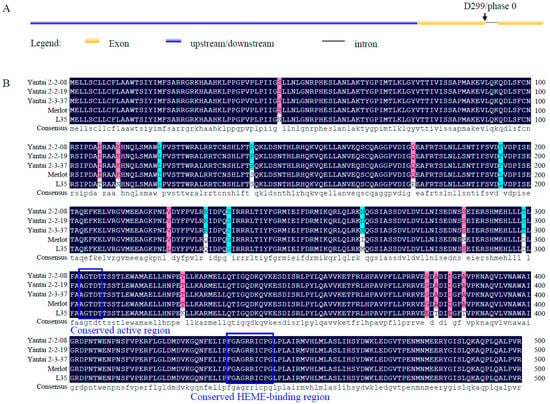
Figure 1.
Gene structure and amino acid sequence alignment analysis of VvCYP76F14 proteins. (A) Gene structure of VvCYP76F14s derived from three mutant lines. (B) Acid sequence alignment of VvCYP76F14 proteins.
Although amino acid sequences of ‘Yantai2-2-08’, ‘Yantai 2-2-19’, and ‘Yantai 2-3-37’ VvCYP76F14s were identical, variations were found among these three offspring lines, ‘Merlot’, and ‘L35’ VvCYP76F14s (Figure 1B). Compared to Full-Bodied ‘L35’ VvCYP76F14, 17 site variations (N46S, T107I, N111K, I120L, S140P, R175Q, L194F, L222V, Q230R, G235S, M264N, D299T, K325T, E378G, T380A, E383D, and T386A) were found in ‘Yantai2-2-08’, ‘Yantai 2-2-19’, and ‘Yantai 2-3-37’ Neutral offspring lines, whereas 12 site mutations (N46S, T107I, N111K, R175Q, L222V, M264I, S286N, K325T, E378G, T380A, E383D, and T386A) were identified in Aromatic ‘Merlot’. Compared to Aromatic ‘Merlot’ VvCYP76F14, seven site variations (S140P, L194F, Q230R, G235S, I264N, N286S, and D299T) were found in ‘Yantai2-2-08’, ‘Yantai 2-2-19’, and ‘Yantai 2-3-37’ Neutral offspring lines. Interestingly, D299T variation was only found in VvCYP76F14s of three Neutral lines. However, the expression levels of all VvCYP76F14 genes were non-significantly changed (Supplementary Figure S1).
2.3. Phylogenetic Tree Analysis of Plant CYP76 Family Homologs
Phylogenetic tree analysis showed that five VvCYP76F14 homologs were closely clustered together, and they exhibited the closest relationship with the corresponding CYP76 homologue from Santalum spicatum (Figure 2). Moreover, CYP76 homologs belonging to the same genus or family, such as Mangifera indica and Pistacia vera of Anacardiaceae; Citrus clementina and Citrus sinensis of Rutaceae; Herrania umbratical, Theobroma cacao, and Durio zibethinus of Malvaceae; Populus alba, Populus trichocarpa, Populus euphratic, Salix suchowensis, Populus tomentosa, Populus deltoides, and Populus euphratica of Salicaceae; and Prunus dulcis, Populus persica, Populus avium, Populus armeniaca, Fragaria vesca, Malus domestica, and Malus sylvestris of Rosaceae, exhibited a closer genetic distance during long-term evolution (Figure 2).
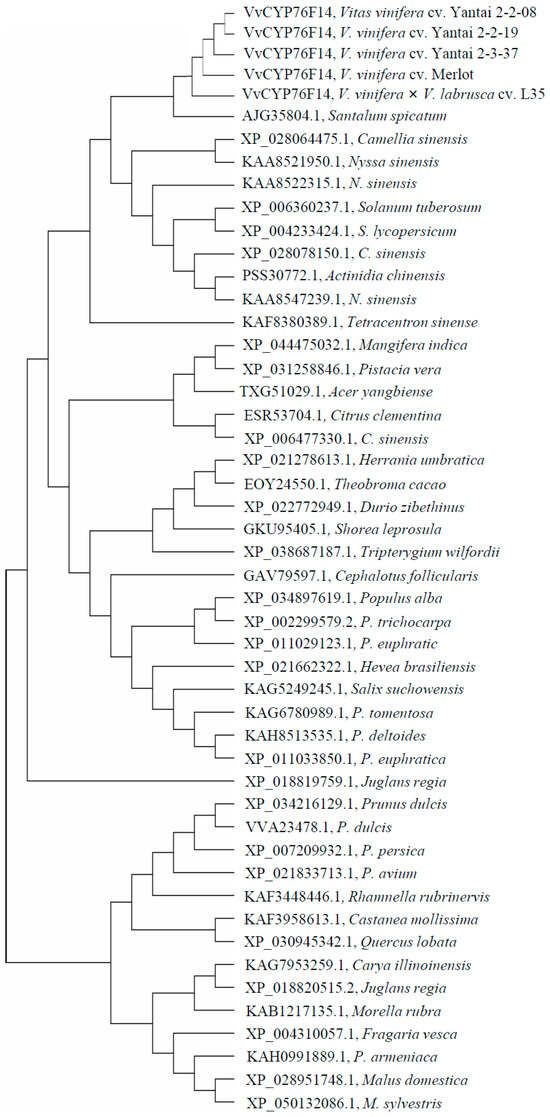
Figure 2.
Phylogenetic analysis of plant CYP76 homologs. The phylogenetic tree of plant CYP76 homologs from wine grape and 41 other species was constructed employing the Maximum-Likelihood method in MEGA 13.0 software.
2.4. VvCYP76F14 Is Localized in the Endoplasmic Reticulum
To investigate the subcellular localization of VvCYP76F14, pBWA(V)HS-ccdb-Glosgfp or pBWA(V)HS-VvCYP76F14-Glosgfp was expressed in Arabidopsis mesophyll protoplasts. Confocal determination revealed that the fluorescence of GFP in protoplasts transformed with pBWA(V)HS-ccdb-Glosgfp (empty vector) was observed in various organelles, especially in the cytoplasm, whereas fluorescence of pBWA(V)HS-VvCYP76F14-Glosgfp was determined in the endoplasmic reticulum (ER) (Figure 3), which implies that VvCYP76F14 is a typical ER-localized protein.
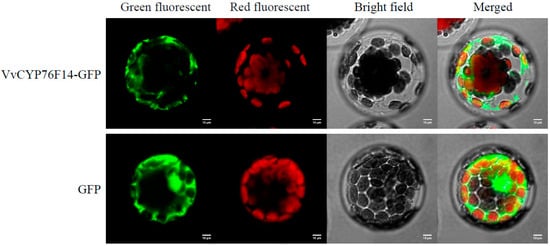
Figure 3.
Subcellular localization of VvCYP76F14. The CDS of VvCYP76F14 derived from ‘Yantai 2-2-08’ and ‘Yantai 2-2-08’ and further cloned into the pBWA(V)HS-ccdb-GLosgfp vector. The GV3101 strain harboring the pBWA(V)HS-CYP76F14-Glosgfp or the empty vector was infiltrated into Arabidopsis mesophyll protoplasts. The GFP fluorescence and chloroplast autofluorescence were observed using the excitation/emission wavelengths 470/510 nm and 620/660 nm, respectively. Scale bar = 10 μm.
2.5. Neutral-Type VvCYP76F14s Exhibited Lower Enzymatic Activity In Vitro
In vitro enzyme activity analysis demonstrated that the catalytic activity of distinct bouquet type VvCYP76F14s in catalyzing linalool, (E)-8-hydroxylinalool, and (E)-8-oxolinalool was quite different, whereas there were no significant changes in the substrate reduction for the negative control substrate (Figure 4). In detail, the ‘L35’ VvCYP76F14 exhibited lower remnants of linalool and (E)-8-hydroxylinalool substrates, compared to ‘Merlot’ and three D299T mutant lines. When taking (E)-8-oxolinalool as a substrate, no significant variation was found in the substrate remnants between ‘L35’ and ‘Merlot’ VvCYP76F14s, and this variation was significantly lower than that of the ‘Yantai2-2-08’, ‘Yantai 2-2-19’, and ‘Yantai 2-3-37’ offspring lines (Figure 4). These findings indicate that the Neutral-type ‘Yantai2-2-08’, ‘Yantai 2-2-19’, and ‘Yantai 2-3-37’ mutant lines exhibited lower in vitro enzymatic activity of VvCYP76F14.
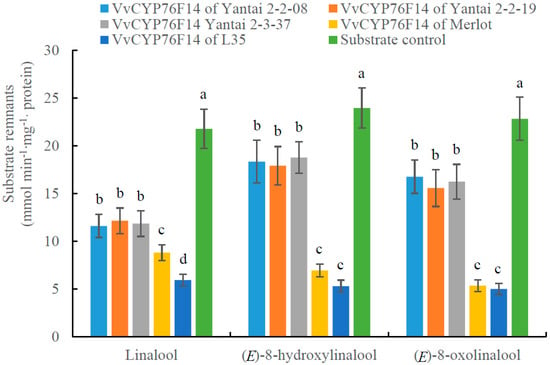
Figure 4.
In vitro activity analysis of VvCYP76F14 in Escherichia coli. The in vitro enzymatic activity of VvCYP76F14 was assayed by measuring the amount of remnant substrate. Data are shown as means ± SE (n = 3). Letters indicate significant differences among five VvCYP76F14s at a significance level of p ≤ 0.05, as determined using ANOVA followed by Fisher’s LSD test.
2.6. Transient Expression of the ‘L35’ or ‘Merlot’ VvCYP76F14 Enhanced the Wine Bouquet Precursor Contents in the D299T Substitution Mutant Lines
According to the natural screening of over 200 hybrid offspring of Chardonnay and Italian Riesling, the D299T substitution was identified in the ‘Yantai2-2-08’, ‘Yantai 2-2-19’, and ‘Yantai 2-3-37’ mutant lines, which had nearly no levels of (E)-8-oxolinalool and (E)-8-carboxylinalool (Figure 1B, Table 1). To further unveil the physiological role of D299T substitution on the activity of VvCYP76F14 in vivo, the VvCYP76F14 CDS isolated from the Full-Bodied variety ‘L35’ or Aromatic variety ‘Merlot’ was transiently over-expressed in ‘Yantai2-2-08’, ‘Yantai 2-2-19’, and ‘Yantai 2-3-37’ berries, respectively. These findings indicated that the contents of (E)-8-hydroxylinalool, (E)-8-oxolinalool, and (E)-8-carboxylinalool in ‘Yantai2-2-08’ berries transformed with ‘L35’ or ‘Merlot’ VvCYP76F14 were significantly higher than berries transformed with ‘Yantai2-2-08’ VvCYP76F14, berries transformed with the pMDC32-HPB empty vector, and the wild-type berries, respectively, and the contents of three distinct linalool-derivative compounds in ‘Yantai2-2-08’ berries transformed with ‘L35’ VvCYP76F14 were higher than the contents of those transformed with ‘Merlot’ VvCYP76F14 (Figure 5A). In addition, the level of linalool in ‘Yantai2-2-08’ berries transformed with ‘L35’ or ‘Merlot’ VvCYP76F14 was significantly lower than that in berries transformed with ‘Yantai2-2-08’ VvCYP76F14, berries transformed with the pMDC32-HPB empty vector, and the wild-type berries, respectively. However, the contents of linalool and three linalool-derivative compounds in berries transformed with ‘Yantai 2-2-08’ VvCYP76F14 were non-significantly changed, compared with berries transformed with the empty vector and the wild-type berries (Figure 5A). Similar findings were observed in the transformed ‘Yantai 2-2-19’ berries (Figure 5B) and ‘Yantai 2-3-37’ berries (Figure 5C).
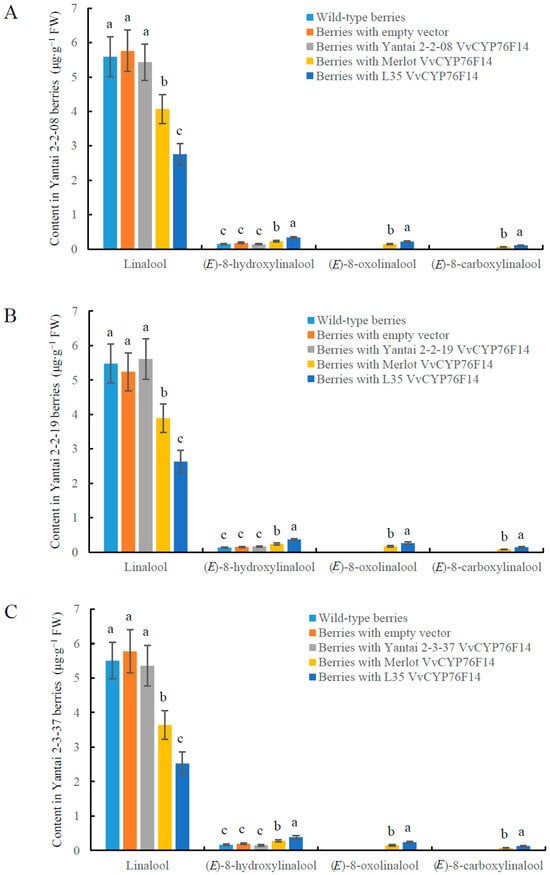
Figure 5.
Transient expression of VvCYP76F14 in berries of D299T mutant lines. The content levels of linalool, (E)-8-hydroxylinalool, (E)-8-oxolinalool, and (E)-8-carboxylinalool in berries of ‘Yantai 2-2-08’ (A), ‘Yantai 2-2-19’ (B), and ‘Yantai 2-3-37’ (C) were assayed by UPLC-MS. Data are shown as means ± SE (n = 3). Letters indicate significant differences among five VvCYP76F14s at a significance level of p ≤ 0.05, as determined using ANOVA followed by Fisher’s LSD test.
3. Discussion
In wine grapes, the cytochrome P450 protein VvCYP76F14 orderly dominates three catalytic processes (hydroxylation, dehydrogenation, and carboxylation) that catalyze linalool into (E)-8-hydroxylinalool, (E)-8-oxolinalool, and (E)-8-carboxylinalool, respectively [8,11,13,14]. In particular, (E)-8-carboxylinalool is the precursor of bicyclic monoterpene lactones that contribute to wine bouquet [8,11,13,14]. However, molecular studies of VvCYP76F14 in regulating wine bouquet precursor formation remain largely unclear.
The active motif signature A(G)G(A)XD(E)T is highly conserved in the Class II monooxygenase domain of the CYP450 family proteins [18,19,20]. In this present study, all five of these VvCYP76F14s encoded a 499-amino-acid polypeptide. The AGTDT motif (located at the 303–307 site, a monooxygenase P450 motif) and the FGAGRRICFG motif (located at the 435–444 site, a HEME-binding region belonging to Class II monooxygenase) were both present in these five VvCYP76F14s (Figure 1B), which was consistent with previous reports in Arabidopsis [8,18] and yeast [21]. Reactions catalyzed by CYP450s can oxidize substrate and create a metabolic channel on the ER that specifically depends on the typical monooxygenase HEME-binding domain (FGAGRRICFG) [14,22]. Indeed, VvCYP76F14s are ER-pitched proteins (Figure 3), suggesting that VvCYP76F14 may have a significant role in metabolic flux during aroma compound biosynthesis.
In fruit crops, the substitution of key amino acid residues in functional enzymes resulted in aromatic component content variations [23,24]. To date, genetic differences among hybrid offsprings possess the potential to enhance wine bouquet and quality [8,11,25,26]. Picard et al. demonstrated that amino acid sequences of VvCYP76F14s derived from different wine grape varieties were kept the same [27]. In contrast to their findings, amino acid variations were found in these five VvCYP76F14s, which directly reflects their distinct wine bouquet precursor contents in berries and in vitro enzymatic activities (Table 1 and Figure 4). These findings imply that VvCYP76F14 could be chosen as a molecular marker to screen amino acid variations in VvCYP76F14 in wine grape offsprings with different wine bouquet types, and further support the proposition that sequence variations in VvCYP76F14s are closely related to wine lactone precursor contents and VvCYP76F14’s enzymatic activities [8].
It is quite interesting that the key amino acid residue D299 was located at the phase 0 intron positions of VvCYP76F14s derived from these three D299T mutant lines (Figure 1A). Notably, (E)-8-oxolinalool and (E)-8-carboxylinalool were hardly detected in D299T mutant lines and the in vitro enzymatic activity of these VvCYP76F14s was significantly lower than that of ‘Merlot’ and ‘L35’ (Table 1 and Figure 4). Moreover, over-expression of VvCYP76F14 from either the Full-Bodied variety ‘L35’ or the Aromatic variety ‘Merlot’ significantly strengthened the production of three distinct linalool-derivative compounds in transgenic berries of all three of these D299T mutant lines (Figure 5). These in vivo observations are consistent with the in vitro enzymatic activities of VvCYP76F14s, supporting their role in regulating the formation of wine bouquet precursors. Nonetheless, these D299T mutant lines are unique and innovative materials to reveal the molecular mechanisms and regulatory studies of VvCYP76F14 enzymes in wine grapes.
4. Materials and Methods
4.1. Chemicals
The primary precursor linalool was purchased from J and K Scientific Co., Ltd. (Shanghai, China). The subsequent precursors of (E)-8-hydroxylinalool, (E)-8-oxolinalool, and (E)-8-carboxylinalool were synthesized and purified by Accela ChemBio Co., Ltd. (Shanghai, China).
4.2. Wine Grape
This study was carried out as a collaboration between Yantai Academy of Agricultural Sciences (Yantai, China) and the University of Cambridge (Cambridge, UK) during the years of 2022, 2023, and 2024. According to previous studies [8], ‘Merlot’ is a typical Aromatic-type and ‘L35’ is a traditional Full-Bodied-type wine grape variety. Three unique offspring lines of ‘Yantai 2-2-08’, ‘Yantai 2-2-19’, and ‘Yantai 2-3-37’ are naturally obtained hybrid offsprings of Chardonnay (Neutral type) and Italian Riesling (Neutral type) that carry the same D299T mutation in their VvCYP76F14s, respectively. Wine grape berries with identical maturity stages were harvested from the National Grape Germplasm Repository (Yantai, China), quickly frozen in liquid nitrogen, and then stored at −80 °C in a fridge.
4.3. Analysis of Linalool and Linalool-Derived Compounds in Wine Grape Berries
The contents of linalool, (E)-8-hydroxylinalool, (E)-8-oxolinalool, and (E)-8-carboxylinalool in wine grape berries were determined using Ultra-Performance Liquid Chromatography—Mass Spectrometry (UPLC-MS) (Waters, Milford, MA, USA). In particular, linalool and linalool derivatives in wine grape berries were well glycosylated before UPLC-MS analysis, and the acid hydrolysis of wine grape samples was carried out at pH 3. Three biological replicates were performed, each with 40 individual berries.
4.4. Isolation and Sequence Analysis of VvCYP76F14s from Different Varieties or Offspring Lines
Total RNA was extracted from ‘Yantai 2-2-08’, ‘Yantai 2-2-19’, ‘Yantai 2-3-37’, ‘Merlot’, and ‘L35’ wine grape berries using a MiniBEST Plant RNA Extraction Kit (TaKaRa, Dalian, China), and DNA contamination was removed using RNase-free Recombinant DNase I (TaKaRa, Dalian, China). The first-strand cDNA was synthesized using a PrimeScript II First Strand cDNA Synthesis Kit (TaKaRa, Dalian, China). The coding sequences (CDSs) of VvCYP76F14 were amplified using the Prime STAR™ HS DNA polymerase (TaKaRa, Dalian, China) from five wine grape varieties or offspring lines with specific primer pairs (Forward: 5′-ATGGAGTTGTTGAGTTGTCTG-3′; Reverse: 5′-TCAAACCCGTACAGGTAGAGCTTGCAG-3′) [8,13]. The PCR products were sequenced and verified by Shenggong Bioengineering Co., Ltd. (Shanghai, China).
4.5. Phylogenetic Tree Analysis
Sequence alignment of VvCYP76f14s from 5 wine grape varieties or offspring lines was analyzed using DNAMAN software 8.0. The phylogenetic tree of plant CYP76 homologs from wine grape and other 41 species was constructed employing the Maximum-Likelihood method in MEGA 13.0 software.
4.6. Real-Time Quantitative PCR
The real-time quantitative PCR (qRT-PCR) analysis was carried out via the LightCycler® 480 system (Roche, Inc., Basel, Switzerland) labeled with SYBR Green qPCR Master Mix (TaKaRa, Dalian, China). The primer pair used for qRT-PCR was as follows: F: 5′-TGTTATCCAACACCATAT-3′; R: 5′-TCCCAGCTTCCTCCATCACA-3′ [8].
4.7. Subcellular Localization of VvCYP76F14
Subcellular localization of VvCYP76F14 was conducted as described by Peng et al. [28]. The CDS of VvCYP76F14 (without termination codon) was amplified from ‘Yantai 2-2-08’ and further cloned into the pBWA(V)HS-ccdb-GLosgfp vector (RiORUN, Wuhan, China), using BsaI and Eco31I restriction sites, to generate the recombinant vector pBWA(V)HS-CYP76F14-GLosgfp. The GV3101 (pSoup-P19, Weidi Biotechnology Co., Ltd., Shanghai, China) strain harboring the pBWA(V)HS-CYP76F14-Glosgfp or the empty vector was infiltrated into Arabidopsis mesophyll protoplasts. Confocal observations were carried out via an Inverted Microscope and a Laser Confocal Scanning Microscope LSM880 (Carl Zeiss, Oberkochen, Germany). The GFP fluorescence and chloroplast autofluorescence were observed using the excitation/emission wavelengths 470/510 nm and 620/660 nm, respectively.
4.8. Heterologous Expression of VvCYP76F14 in E. coli
Heterologous expression of VvCYP76F14 in E. coli was conducted as previously described [8]. The CDSs of the VvCYP76F14s from ‘Yantai 2-2-08’, ‘Yantai 2-2-19’, ‘Yantai 2-3-37’, ‘Merlot’, and ‘L35’ were synthesized and verified by GenScript Co., Ltd. (Nanjing, China). These confirmed constructs were heterologously expressed in the E. coli BL21(DE3) strain. The confirmation of the recombinant proteins was performed using Liquid Chromatography–Tandem Mass Spectrometry/Mass Spectrometry (LC-MS/MS) by Shanghai Bioprofile Technology Co., Ltd. (Shanghai, China).
4.9. In Vitro Enzymatic Activity Determination
In vitro enzyme activity of VvCYP76F14 was studied according to the description of Peng et al. [8]. The enzyme activities of recombinant VvCYP76F14s from ‘Yantai 2-2-08’, ‘Yantai 2-2-19’, ‘Yantai 2-3-37’, ‘Merlot’, and ‘L35’ were determined using linalool, (E)-8-hydroxylinalool, and (E)-8-oxolinalool as the substrate, respectively. The Arabidopsis CPR (ATR1 [8,14]) was selected as the electron transport redox partner of VvCYP76F14, with the intent to reconstitute the membrane-bound monooxygenase system and minimize the interference from multiple wine grape NADPH CPR homologs. Reactions were carried out at 26 °C for 1 h with agitation, and the substrate reduction and remnants were analyzed using Ultra-Performance Liquid Chromatography–Mass Spectrometry (UPLC-MS) (Waters, Milford, MA, USA) [8,13]. All assays were performed three times, each with 40 individual berries.
4.10. Over-Expression of VvCYP76F14 in Berries of D299T Mutant Lines
To evaluate the enzymatic activity of VvCYP76F14 in berries, the CDS of VvCYP76F14 was isolated from ‘L35’, ‘Merlot’, or D299T mutant lines, respectively, and synthesized by GenScript Co., Ltd. (Nanjing, China). Sequencing-verified VvCYP76F14 was cloned into the pMDC32-HPB (Addgene: 32078) to generate the recombinant plasmid pMDC32-HPB-CYP76F14. The pMDC32-HPB-VvCYP76F14 over-expression vector and empty vector were each transferred into the GV3101 (WEIDI, Shanghai, China) strain. The GV3101 suspension with an OD600 of 0.8 was injected into the veraison-stage berries of ‘Yantai 2-2-08’, ‘Yantai 2-2-19’, ‘Yantai 2-3-37’, ‘Merlot’, and ‘L35’, respectively, in the early morning at three points individually around the diameter of the berries. After injection for three days, the content levels of linalool, (E)-8-hydroxylinalool, (E)-8-oxolinalool, and (E)-8-carboxylinalool in wine grape berries were assayed by UPLC-MS (Waters, Milford, MA, USA). Three biological replicates were performed, each with 40 individual berries.
4.11. Statistical Analysis
The significant differences were analyzed in SPSS 13.0 (Armonk, New York, NY, USA) using ANOVA followed by Fisher’s LSD test method.
5. Conclusions
D299T variation was observed in VvCYP76F14s of ‘Yantai 2-2-08’, ‘Yantai 2-2-19’, and ‘Yantai 2-3-37’ offspring lines, and was correlated with the decreased content of wine bouquet precursors of (E)-8-hydroxylinalool, (E)-8-oxolinalool, and (E)-8-carboxylinalool and reduced in vitro enzymatic activity. Transient expression of VvCYP76F14 cloned from Full-Bodied- or Aromatic-type varieties restored the levels of wine bouquet precursors in berries of three D299T mutant lines, whereas VvCYP76F14 cloned from D299T mutant lines failed.
Supplementary Materials
The following supporting information can be downloaded at https://www.mdpi.com/article/10.3390/genes15111478/s1, Figure S1: Expression levels of VvCYP76F14s from five varieties or offspring lines.
Author Contributions
W.L., H.X. and Z.S.: were responsible for the original screening, writing—original draft preparation, and research plans; W.L., H.X., M.T. and M.S.: methodology, investigation, data curation. All authors have read and agreed to the published version of the manuscript.
Funding
This study was supported by grants from the Major Project of Science and Technology of Shandong Province (2022CXGC010605), the China Agriculture Research System of MOF and MARA (CARS-29-17), the Fund of China Scholarship Council (202208370080), and UKRI BBSRC (X008843/1).
Institutional Review Board Statement
Not applicable. The study utilized publicly available data from the NCBI database.
Informed Consent Statement
Not applicable.
Data Availability Statement
The original contributions presented in the study are included in the article and Supplementary Materials, further inquiries can be directed to the corresponding author.
Acknowledgments
The authors are grateful to Julia M. Davies, Department of Plant Sciences, University of Cambridge, for the critical reading and valuable suggestions.
Conflicts of Interest
The authors declare no conflicts of interest.
References
- Alegre, Y.; Saenz-Navajas, M.P.; Hernandez-Orte, P.; Ferreira, V. Sensory, olfactometric and chemical characterization of the aroma potential of Garnacha and Tempranillo winemaking grapes. Food Chem. 2020, 331, 127207. [Google Scholar] [CrossRef] [PubMed]
- Robinson, A.L.; Boss, P.K.; Solomon, P.S.; Trengove, R.D.; Heymann, H.; Ebeler, S.E. Origins of grape and wine aroma. Part 2. Chemical and sensory analysis. Am. J. Enol. Vitic. 2014, 65, 25–42. [Google Scholar] [CrossRef]
- Thomas-Danguin, T.; Ishii-Foret, A.; Atanasova, B.; Etievant, P. Wine bouquet: The perceptual integration of chemical complexity. In Wine Active Compounds; Conference Object; Oenoplurimédia: Beaune, France, 2011. [Google Scholar]
- Zhai, H.Y.; Li, S.Y.; Zhao, X.; Lan, Y.B.; Zhang, X.K.; Shi, Y.; Duan, C.Q. The compositional characteristics, influencing factors, effects on wine quality and relevant analytical methods of wine polysaccharides: A review. Food Chem. 2023, 403, 134467. [Google Scholar] [CrossRef] [PubMed]
- Noguerol-Pato, R.; Gonzalez-Barreiro, C.; Cancho-Grande, B.; Santiago, J.L.; Martinez, M.C.; Simal-Gandara, J. Aroma potential of Brancellao grapes from different cluster positions. Food Chem. 2012, 132, 112–124. [Google Scholar] [CrossRef]
- Lukic, I.; Lotti, C.; Vrhovsek, U. Evolution of free and bound volatile aroma compounds and phenols during fermentation of Muscat blanc grape juice with and without skins. Food Chem. 2017, 232, 25–35. [Google Scholar] [CrossRef]
- Wang, X.J.; Tao, Y.S.; Wu, Y.; An, R.Y.; Yue, Z.Y. Aroma compounds and characteristics of noble-rot wines of Chardonnay grapes artificially botrytized in the vineyard. Food Chem. 2017, 226, 41–50. [Google Scholar] [CrossRef]
- Peng, B.; Ran, J.G.; Li, Y.Y.; Tang, M.L.; Xiao, H.L.; Shi, S.P.; Ning, Y.Z.; Dark, A.; Guan, X.Q.; Song, Z.Z. Site-directed mutagenesis of VvCYP76F14 (cytochrome P450) unveils its potential for selection in wine grape varieties linked to the development of wine bouquet. J. Agric. Food Chem. 2024, 72, 3683–3694. [Google Scholar] [CrossRef]
- Parker, M.; Capone, D.L.; Francis, I.L.; Herderich, M.J. Aroma Precursors in Grapes and Wine: Flavor Release during Wine Production and Consumption. J. Agric. Food Chem. 2017, 66, 2281–2286. [Google Scholar] [CrossRef]
- Ghaste, M.; Narduzzi, L.; Carlin, S.; Vrhovsek, U.; Shulaev, V.; Mattivi, F. Chemical composition of volatile aroma metabolites and their glycosylated precursors that can uniquely differentiate individual grape cultivars. Food Chem. 2015, 188, 309–319. [Google Scholar] [CrossRef]
- Lin, J.; Massonnet, M.; Cantu, D. The genetic basis of grape and wine aroma. Hortic. Res. 2019, 6, 81. [Google Scholar] [CrossRef]
- Giaccio, J.; Capone, D.L.; Håkansson, A.E.; Smyth, H.E.; Elsey, G.M.; Sefton, M.A.; Taylor, D.K. The formation of wine lactone from grape-derived secondary metabolites. J. Agric. Food Chem. 2011, 59, 660–664. [Google Scholar] [CrossRef] [PubMed]
- Ilc, T.; Halter, D.; Miesch, L.; Lauvoisard, F.; Kriegshauser, L.; Ilg, A.; Baltenweck, R.; Hugueney, P.; Werck-Reichhart, D.; Duchêne, E.; et al. A grapevine cytochrome P450 generates the precursor of wine lactone, a key odorant in wine. N. Phytol. 2017, 213, 264–274. [Google Scholar] [CrossRef] [PubMed]
- Kunert, M.; Langley, C.; Lucier, R.; Ploss, K.; López, C.Z.R.; Guerrero, A.D.S.; Rothe, E.; O’Connor, S.E. Promiscuous CYP87A enzyme activity initiates cardenolide biosynthesis in plants. Nat. Plants 2023, 9, 1607–1617. [Google Scholar] [CrossRef] [PubMed]
- Zhang, B.; Lewis, K.M.; Abril, A.; Davydov, D.R.; Vermerris, W.; Sattler, S.E.; Kang, C. Structure and function of the cytochrome P450 monooxygenase cinnamate 4-hydroxylase from Sorghum Bicolor. Plant Physiol. 2020, 183, 957–973. [Google Scholar] [CrossRef] [PubMed]
- Yang, Y.; Jin, G.J.; Wang, X.J.; Kong, C.L.; Liu, J.; Tao, Y.S. Chemical profiles and aroma contribution of terpene compounds in Meili (Vitis vinifera L.) grape and wine. Food Chem. 2019, 284, 155–161. [Google Scholar] [CrossRef]
- Cheng, J.; Li, J.; Zhou, P.H.; Jian, M.D.; Dong, Y.W.; Wang, T.Q.; Wu, F.; Qiu, H. Study on the difference of phenolic substances in different wine grapes from Jiaodong peninsula Shandong province. Food Eng. 2020, 1, 71–75. (In Chinese) [Google Scholar]
- Hofer, R.; Dong, L.; Andre, F.; Ginglinger, J.F.; Lugan, R.; Gavira, C.; Grec, S.; Lang, G.; Memelink, J.; Van der Krol, S.; et al. Geraniol hydroxylase and hydroxygeraniol oxidase activities of the CYP76 family of cytochrome P450 enzymes and potential for engineering the early steps of the (seco) iridoid pathway. Metab. Eng. 2013, 20, 221–232. [Google Scholar] [CrossRef]
- Hofer, R.; Boachon, B.; Renault, H.; Gavira, C.; Miesch, L.; Iglesias, J.; Ginglinger, J.F.; Allouche, L.; Miesch, M.; Grec, S.; et al. Dual function of the cytochrome P450 CYP76 family from Arabidopsis thaliana in the metabolism of monoterpenols and phenylurea herbicides. Plant Physiol. 2014, 166, 1149–1161. [Google Scholar] [CrossRef]
- Renault, H.; Bassard, J.E.; Hamberger, B.; Werck-Reichhart, D. Cytochrome P450-mediated metabolic engineering: Current progress and future challenges. Curr. Opin. Plant Biol. 2014, 19, 27–34. [Google Scholar] [CrossRef] [PubMed]
- Bathe, U.; Frolov, A.; Porzel, A.; Tissier, A. CYP76 oxidation network of abietane diterpenes in lamiaceae reconstituted in yeast. J. Agric. Food Chem. 2019, 67, 3437–13450. [Google Scholar] [CrossRef]
- Walsh, C.T.; Wencewicz, T.A. Flavoenzymes: Versatile catalysts in biosynthetic pathways. Nat. Prod. Rep. 2013, 30, 175–200. [Google Scholar] [CrossRef] [PubMed]
- Song, Z.Z.; Peng, B.; Gu, Z.X.; Tang, M.L.; Li, B.; Liang, M.X.; Wang, L.M.; Guo, X.T.; Wang, J.P.; Sha, Y.F.; et al. Site-directed mutagenesis identified the key active site residues of alcohol acyltransferase PpAAT1 responsible for aroma biosynthesis in peach fruits. Hortic. Res. 2021, 8, 32. [Google Scholar] [CrossRef] [PubMed]
- Peng, B.; Yu, M.L.; Zhang, B.B.; Xu, J.L.; Ma, R.J. Differences in PpAAT1 activity in high- and low-aroma peach varieties affect γ-decalactone production. Plant Physiol. 2020, 182, 2065–2080. [Google Scholar] [CrossRef] [PubMed]
- D’Onofrio, C.; Matarese, F.; Cuzzola, A. Effect of methyl jasmonate on the aroma of Sangiovese grapes and wines. Food Chem. 2018, 242, 352–361. [Google Scholar] [CrossRef]
- Riffle, V.L.; Arredondo, J.A.; LoMonaco, I.; Appel, C.; Catania, A.A.; Peterson, J.C.D.; Casassa, L.F. Vine age affects vine performance, grape and wine chemical and sensory composition of cv. Zinfandel from California. Am. J. Enol. Vitic. 2022, 73, 277–293. [Google Scholar] [CrossRef]
- Picard, M.; Tempere, S.; de Revel, G.; Marchand, S. A sensory study of the ageing bouquet of red Bordeaux wines: A three-step approach for exploring a complex olfactory concept. Food Qual. Prefer. 2015, 42, 110–122. [Google Scholar] [CrossRef]
- Peng, B.; Gu, Z.X.; Zhou, Y.F.; Ning, Y.Z.; Xu, H.Y.; Li, G.; Ni, Y.; Sun, P.P.; Xie, Z.Q.; Shi, S.P.; et al. Potential role of fatty acid desaturase 2 in regulating peach aroma formation. Postharvest Biol. Technol. 2023, 204, 112473. [Google Scholar] [CrossRef]
Disclaimer/Publisher’s Note: The statements, opinions and data contained in all publications are solely those of the individual author(s) and contributor(s) and not of MDPI and/or the editor(s). MDPI and/or the editor(s) disclaim responsibility for any injury to people or property resulting from any ideas, methods, instructions or products referred to in the content. |
© 2024 by the authors. Licensee MDPI, Basel, Switzerland. This article is an open access article distributed under the terms and conditions of the Creative Commons Attribution (CC BY) license (https://creativecommons.org/licenses/by/4.0/).